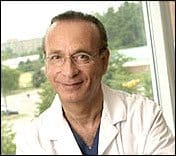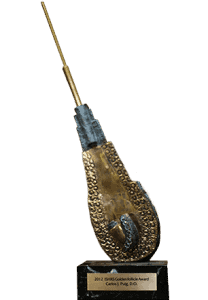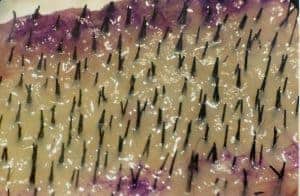
One of the true pioneers of surgical hair restoration, a true global pioneer in the field, is Dr David J Seager.
Dr Seager founded The Seager Hair Transplant Centre and was instrumental in pioneering the Uni-Strand™ hair transplant methods we use here at the Sure hair transplant centre in Toronto. Dr Seager was the first to perform high density “one pass” sessions, high-density sessions meaning in excess of 3,000 grafts at a time. He performed this procedure in the mid-1990s and continued to teach and practice this technique. Today, Sure Hair International still practices, performs and refines the techniques Dr Seager pioneered. Even after 30 years of development and refinement we continue to evolve and invest enormous amounts of resources into further research and development of the Uni-Strand™ process. The International Society of Hair Restoration Surgeons has awarded Dr A.k. Gupta at Sure Hair International the Global Platinum Follicle Award this year for the individual contributing the most in the areas of research and development of hair transplantation.
Dr Seager also established what would become known within the surgical hair restoration community as “Ultra Refined FUT”. Dr Seager would place 3,000 grafts densely packed “One area – One session”, and then the grafts were immediately placed into the incision after the tiny needle incision was made. This technique is referred to as the “stick and place” technique and it has become an important component of our Uni-Strand hair transplant protocol.
STICK AND PLACE
 Dr Seager used an old fashioned 4mm punch, plug grafts, mini-micro grafts, follicular unit grafts as harvested by strip surgery and follicular unit extraction (FUE). Later, implanter pens were introduced to the procedure and have made stick and place a much more popular and simple placement technique. In a traditional FUT procedure the follicular units grafts (hairs) are obtained from the back of the scalp (sometimes from other areas of the scalp and body as well).
Dr Seager used an old fashioned 4mm punch, plug grafts, mini-micro grafts, follicular unit grafts as harvested by strip surgery and follicular unit extraction (FUE). Later, implanter pens were introduced to the procedure and have made stick and place a much more popular and simple placement technique. In a traditional FUT procedure the follicular units grafts (hairs) are obtained from the back of the scalp (sometimes from other areas of the scalp and body as well).
These hairs are first removed from the donor zone and then implanted onto the scalp by generating small incisions called ‘recipient sites’. The surgeon and his team typically make all of the recipient site incisions first and then implant the follicular hair units into each recipient site. However, with the ‘stick and place’ technique, the follicular hair unit will be placed into the recipient site immediately after the incision is made, and this will be continued until the hair restoration procedure is complete.
As the skin is very elastic, incisions will shrink over time. During a traditional surgical procedure, the surgical team will compensate for this by making the incisions slightly larger than the grafts. So when the graft is ready for implantation, the incision is the correct size. With the ‘stick and place’ technique, the recipient site has less time to shrink, so the recipient site is closer to the size of the grafts placed into the recipient site, thereby significantly reducing the size of the thousands of implantation scars.
Smaller incisions may mean less bleeding (and therefore fewer infections and complications such as necrosis), denser-looking hair and minimal scarring. Additionally, the ‘stick and place; technique may result in a decrease in the amount of epinephrine required to control bleeding. Therefore, with the ‘stick and place’ technique, grafts could be subjected to less hypoxia, and this may manifest in better clinical results.
Uni-Strand™ TECHNIQUE
 At Sure Hair International, we have our signature Uni-Strand™ Hairline, which uses the ‘stick and place’ method as well as dense packing.
At Sure Hair International, we have our signature Uni-Strand™ Hairline, which uses the ‘stick and place’ method as well as dense packing.
With this method, we can ensure that we are able to perfectly implant even the smallest single unit of hair grafts into the scalp without damaging the hair bulb. This provides a higher hair graft survival rate and ensures that the hairs are implanted at the correct angulation to the scalp increasing the regrowth rate and ultimately the value of a Uni-Strand™ hair transplant for the patient. Together these surgical advancements makes the transplanted hair look as natural as your own growing hair.
This single Uni-Strand™ “stick and place” method improves our results because we are able to achieve denser-looking results with fewer grafts, as this method helps ensure a higher hair graft success rate when transplanting.
Dr Seager believed that with the ‘stick and place’ technique, one could more densely pack “chubbier” grafts. He liked this because he believed that telogen (i.e. invisible resting) follicles and chubbier grafts generally survive better than “skinny” grafts. These findings were confirmed in a study by Dr Seager in 1997 and Dr Beehner in 1999 comparing chubby versus skinny grafts. Chubby grafts have a higher regrowth rate than skinny grafts after 6 months1,2.

Dr Seager was one of the first surgeons to stop using punch grafts and implement mini graft transplantation to help his signature dense packing, natural hair look.
In fact, in 2001, Dr Seager has recognized for his “signature” one-pass technique when the International Society of Hair Restoration Surgeons presented him with the Golden Follicle Award.
This technique provides patients with a much more natural hairline than other techniques used in the past, such as scalp reduction.
Scalp reduction is a process in which an area of bald skin is cut out and removed from the top and back of the scalp and then the resulting gap is then stitched closed.
Scalp reduction reduces the size of the area requiring transplantation and has been in conjunction with other treatments. This is not recommended today as multiple, painful procedures are required, and additionally, the skin can stretch back, so a previously bald crown will again become a bald crown, but there will also be an unnatural scar.
It can also lead to the dispersal of the donor hair so that less donor hair can be manipulated. It is rare to perform a scalp reduction these days. Clearly, Dr Seager pioneered this dense-packing of follicular unit grafts to complete an area of baldness in one session.
At Sure Hair International’s clinics in Toronto, Canada we have been performing dense-packed follicular unit hair transplantation and are continually working to improve on the technique even further.
Sure Hair International 180 Bloor Street West, Toronto, Ontario
REFERENCES
1. Beehner ML. A comparison of hair growth between follicular-unit grafts trimmed “skinny” vs. “chubby.” Dermatol Surg Off Publ Am Soc Dermatol Surg Al. 1999 Apr;25(4):339–40.
2. Seager DJ. Micrograft size and subsequent survival. Dermatol Surg Off Publ Am Soc Dermatol Surg Al. 1997 Sep;23(9):757–761; discussion 762.












